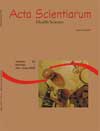<b>Action of Canova<sup>®</sup> medicine onto peritoneal resident macrophages infected with Trypanosoma cruzi</b> - DOI: 10.4025/actascihealthsci.v30i1.354
Keywords:
homeopathy, Trypanosoma cruzi, Canova
Abstract
Approximately 20 million of people are chronically infected with Trypanosoma cruzi in Latin America. The present work investigated the action of the homeopathic medicine Canova® in in vitro experimental infections with T.cruzi, type Y, using Swiss mice peritoneal resident macrophages. Our results demonstrated that Canova® induced a decrease in the production of H2O2 and TNF-α at 20% and 40% concentrations when compared to the control RPMI. However, when compared with this medicine excipient, there was a significant decrease of these nediators at 40% concentration only. The production of NO and the phagocytic activity were not affected. TNF-α inhibits the T.cruzi replication in peritoneal macrophages in vitro, becoming an important agent of infection control by this parasite. Within this context, Canova®, unlike what has been reported to other infections, would function as a stimulator of the infection, since it inhibited the production of TNF-α by peritoneal resident macrophages in vitro. Further studies should be carried out with elicited macrophages, in order to confirm the Canova® inhibitory activity on the production of TNF-α and other mediators in macrophages infected by T.cruzi.Downloads
Download data is not yet available.
Published
2008-07-24
How to Cite
Oliveira, V. T. C. de, Cardozo, D. M., Dalalio, M. M. de O., Araújo, S. M. de, Amado, C. A. B., & Moliterno, R. A. (2008). <b>Action of Canova<sup>®</sup> medicine onto peritoneal resident macrophages infected with Trypanosoma cruzi</b> - DOI: 10.4025/actascihealthsci.v30i1.354. Acta Scientiarum. Health Sciences, 30(1), 33-39. https://doi.org/10.4025/actascihealthsci.v30i1.354
Issue
Section
Pharmacy
DECLARATION OF ORIGINALITY AND COPYRIGHTS
I Declare that current article is original and has not been submitted for publication, in part or in whole, to any other national or international journal.
The copyrights belong exclusively to the authors. Published content is licensed under Creative Commons Attribution 4.0 (CC BY 4.0) guidelines, which allows sharing (copy and distribution of the material in any medium or format) and adaptation (remix, transform, and build upon the material) for any purpose, even commercially, under the terms of attribution.
Read this link for further information on how to use CC BY 4.0 properly.























5.png)







